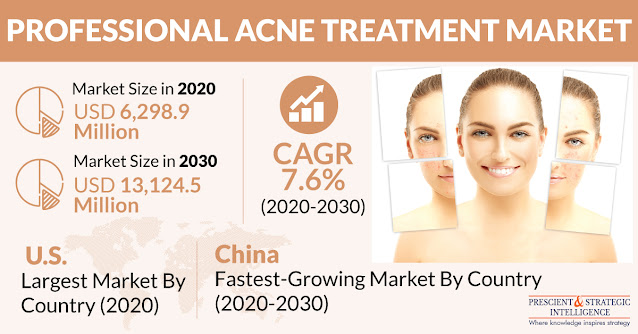How Will Rising Demand for Professional Acne Treatment Market?
The Royal Australian College of General Practitioners (RACGP) estimates that more than 90% of adolescents aged 16–18 years in Australia are affected by acne vulgaris. Likewise, the European Academy of Dermatology and Venereology conducted a study in Spain, France, Belgium, the Czech Republic, Italy, and Poland to extract data on the prevalence of acne. The study revealed that approximately 57.8% of the population of these nations had acne. Thus, the increasing incidence of acne will facilitate the usage of professional acne treatment drugs in the coming years.
Read More Active Professional Acne Treatment Market Overview
Acne patients can use antibiotics, combinations, hormonal agents, retinoids, and electroporation (ELP), infrared laser, intense pulsed light (IPL), laser, photopneumatic, potassium titanyl phosphate laser, pulsed dye laser, photodynamic, and radiofrequency devices to treat their skin. These drugs and devices can be applied to inflammatory and non-inflammatory acne. The aforementioned products are prescribed by cosmeticians and dermatologists. In the coming years, dermatologists will be the dominant users of such drugs and devices as patients prefer dermatologists due to their greater experience and expertise in treating skin problems.
Geographically, the North American region dominated the professional acne treatment market in the last few years due to the high prevalence of acne and the presence of an extensive pipeline of drugs and leading producers of dermatology drugs in the U.S. and Canada. The Canadian Dermatology Association estimates that acne affects around 5.6 million people in Canada, accounting for nearly 20% of the population of the country. Likewise, the American Academy of Dermatology (AAD) states that acne affects approximately 50 million Americans annually.
Therefore, the surging cases of acne and rising public awareness about skin problems and skin treatment procedures will augment the usage of professional acne treatment products globally.
This study covers
• Major
factors driving the market and their impact during the short, medium, and long
terms
• Market
restraints and their impact during the short, medium, and long terms
• Recent
trends and evolving opportunities for the market participants
• Historical
and the present size of the market segments and understand their comparative
future potential
• Potential
of on-demand logistics services, so the market players make informed decisions
on the sales of their offerings
• Competitive
scenario of various market segments across key countries in several regions for
uncovering market opportunities for the stakeholders
• Major
players operating in the market and their service offerings




Comments
Post a Comment